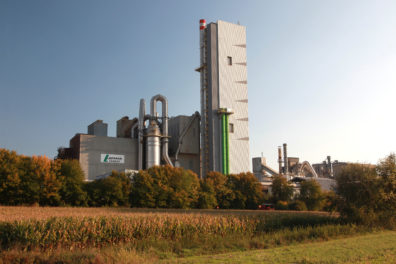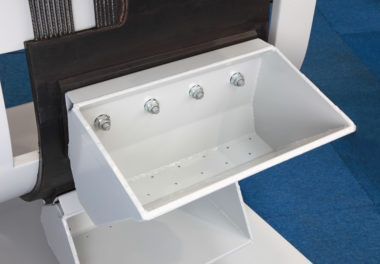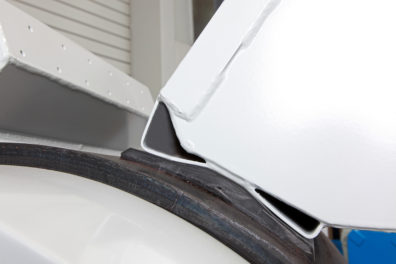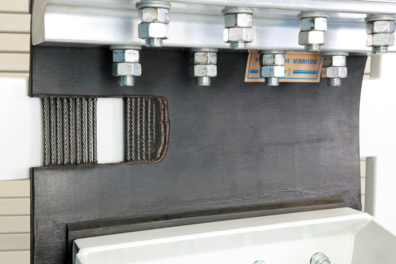BEUMER upgrades Lafarge belt bucket elevator with its heavy-duty technology:
Spectacular residential and office buildings, tunnels and other infrastructure facilities – nothing can be built without cement. To produce cement for various applications in an economic way, Lafarge modernised the production facilities at its plant in the town of Wössingen, in the Baden region, Germany. The modernisation included the existing belt bucket elevator to the raw mill. The intralogistics specialist BEUMER offered its innovative heavy-duty bucket elevators, permitting higher conveying capacity and longer service life. Thanks to this new technology, the existing bucket elevator could be easily altered.
The preheater tower of Lafarge Group’s cement plant looms just a few hundred metres before the sign Wössingen, near Karlsruhe. In the seventies the plant has been taken over by the international producer of cement. “We have almost 78,000 employees in 78 countries“, says Stephan Schenk, Head of Servicing & Development at Lafarge Zement Wössingen GmbH. Worldwide, Lafarge is market leader in many countries, such as France, England, Poland, Greece and Austria. In Germany, Lafarge is among the six leading producers. “Thanks to the state-of-the-art technology and a high sense of responsibility, we produce approximately 800,000 tons cement per day for various applications and requirements at our Wössingen site“, explains Schenk. Lafarge places particular value on production methods that are both energy-efficient and environmentally sound. For this reason, the systems have been modernised for more than 60 million euros in 2008 and 2009. Now, the cement plant has a 5-stage heat exchanger and a new clinker cooler.
“We changed from the Lepol process to the energy-saving dry process with heat exchanger and precalciner with no interruption to the operation. To make the production more cost-effective and environmentally sound, we changed from the two-kiln operation to a single rotary kiln“, explains Schenk. “The kiln line has now a considerably higher capacity. The system is fed with approximate 150 tons of raw material per hour. Accordingly, the complete production has changed“, the engineers says. Due to the increase in performance and modernisation of the kiln line, the flow rate of the bucket elevator for the raw mill had to be increased considerably. The bucket elevator transports limestone to the mill bunker.
High wear of the belt
“Due to the higher flow rates we had to face more problems with the coarse-grained material“, remembers Schenk. Larger particles became repeatedly jammed between belt and bucket, causing substantial wear. Conventional belt bucket elevators are limited by the maximum grain size of the material to be conveyed as the conventional bucket mounting results in a gap of about 25 mm between bucket and belt. Larger particles may get stuck in this gap. This quickly results in belt damage when the belt runs around the return pulleys. “The belt became porous already after two years“, explains Schenk. A new solution needs to be found both to avoid belt cracks and to meet the growing requirements. Nevertheless, long-term thinking was called for. “Because a new belt is very expensive“, adds Schenk.
New heavy-duty technology gets the job done
At first, the engineers from the Wössingen plant wanted to replace the existing belt bucket elevator with a central chain bucket elevator. “We would have solved the problem with the transport of coarse-grained material“, says Schenk, “but a new central chain bucket elevator would have become quite expensive.” In search of a suitable solution, the cement producer contacted some manufacturers of vertical conveyors – among others, the BEUMER Group, headquartered in Beckum, Germany. The cooperation between BEUMER Group and the cement plant in Wössingen has a long tradition. For decades, the market leader has established itself successfully in this sector and could impress the customer with its solution. “When specifying our conditions, BEUMER recommended the newly developed technology“, remembers Schenk. “Central chain bucket elevators which transport limestone are subject to high wear as the raw material contains abrasive particles which act as sandpaper“, says Schenk. Though identical with that of belt bucket elevators if used for materials that have little abrasive action, the service life of chain bucket elevators is much shorter in the case of strongly abrasive materials. After thorough consultation with the BEUMER specialists only the belt and the buckets were renewed applying the new heavy-duty technology. This technology is used to feed material with particle sizes up to 120 mm and up to six percent moisture into the raw mill. “The capacity is now 800 tons per hour“, enthuses Schenk.
This is possible thanks to the new bucket geometry. There is no more gap between belt and bucket. Coarse-grained material do not jam during scooping and filling process. The buckets are mounted firmly to the back of the belt by segments and bolts. Belts with wire-free zones are used for the new heavy-duty bucket elevators just as with all BEUMER belt bucket elevators. The buckets can be fastened to the belt without damaging the steel wires or even cutting them. The traction forces of the bucket elevator belt are maintained to full extend. The new bucket shape also ensures smoother running and thus less noise. Depending on the material to be conveyed, BEUMER offers buckets which are adapted to the material or mounts a dynamic bottom into the bucket elevator boot. This prevents wet and sticky material in the bucket elevator boot. And if explosive material is to be conveyed, all components are available in ATEX version.
To convince the employees of Lafarge by the new technology, BEUMER invited Stephan Schenk and two of his colleagues to Beckum. “The new technology was demonstrated with a miniature bucket elevator. This hits the nail on the head“, he says with a smile. Demands that neither conventional belt bucket elevators nor central chain bucket elevators can meet. “BEUMER adapted the buckets to our specific requirements by using test material.”
A belt that resists high loads
While developing the heavy-duty bucket elevator, the tensile strength of belts with wire-free zones was strengthened. The current belt has a tensile load of 2,500 N/mm, the new belt with wire-free zones has a tensile load of 3,300 N/mm. The conveyor belts are more resistant against mechanical wear, and they are able to transport coarse-grained material and have high tensile load, all this makes the new heavy-duty bucket elevator the favourite conveying system for strongly abrasive material with high capacity and large centre distance. “This belt has twice the service life of a chain. Bucket elevators fitted with this belt are a clear improvement over central chain bucket elevators when used for strongly abrasive material, such as clinker, ore or blast-furnace slag”, Schenk learned in Beckum.
The timeline was tight, just two months to plan and realise the modification. “We’ve got the ball rolling in October. The date of delivery was at the beginning of January and the bucket elevator was operated at the end of February“, Schenk says. Employees of Lafarge carried out the assembly under the watchful eye of the BEUMER specialists. It was less for an undertaking for the cement plant. “BEUMER handled all the planning, we only had to mount the buckets and the belt.”
“This solution saved us a lot of money“, says Schenk. “The complete modification cost about 80,000 euros. In comparison, a new conventional belt would have cost 60,000 euros. If we assume that the BEUMER solution lasts twice as long, the modification would amortise after a short period of time“, stresses Schenk. “Even after six months of operation there are no signs of wear. This was quite different with the old belt.“

















